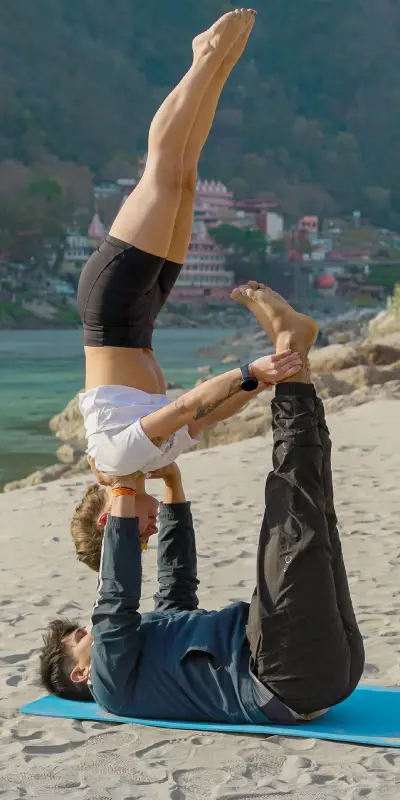
Get A Free Quote


Imagine a more natural approach to keeping your heart healthy that does not involve popping pills that might have many other side effects. Let's start from scratch. Sun Salutation, also referred to as Surya Namaskar, is a sequence of yoga poses that, when done in order, produces a dynamic and energizing practice. Similar to your morning cup of coffee, but with more mental peace and flexibility.
According to research published in the International Journal of Yoga, Surya Namaskar significantly enhances cardiovascular health in healthy adults. After performing Surya Namaskar for 12 weeks, the study subjects displayed appreciable improvements in their blood pressure, cholesterol, and resting heart rate. Amazing, right?
This ancient practice hails from India, where the sun has always been revered as a symbol of life and vitality. Surya Namaskar, therefore, is a gesture of respect and gratitude to the sun, the ultimate life-giver.
You can think of Surya Namaskar as a gentle personal trainer who encourages you to become more flexible. It works wonders at loosening up those tight muscles, and in time you will feel as flexible as a gymnast.
Have a few pounds to lose? You can depend on Surya Namaskar as your ally. It acts as a silent superhero, assisting you in burning calories and maintaining a healthy weight.
Surya Namaskar gets your heart pumping like an energetic drummer in a rock band. The increased blood circulation ensures your heart stays strong and healthy.
It's not just about physical perks; Surya Namaskar offers a delightful mental makeover too.
In our hectic lives, stress is like an unwanted guest. Surya Namaskar evicts this guest, offering you peace and calm. It's like a mini-vacation for your mind.
Surya Namaskar improves mental clarity, similar to putting on glasses for your brain. You will be able to focus better and complete tasks with ease.
Feeling like you are on a rollercoaster of emotions? Surya Namaskar assists in mood stabilization. It is like having an emotional GPS that guides you back to equilibrium.
The idea of honoring the sun stems from the conviction that it is a deity and the source of all life, rather than merely a celestial body. During the Vedic era, Surya, the solar deity, personified the sun, and it was customary to honor its life-giving energy with prayers and salutations. Over time, the Surya Namaskar practice changed. It became a part of many different yoga schools, each with its own set of poses and mantras. This practice has evolved over time, which attests to its enduring appeal and adaptability.
There are twelve postures in the practice, all of which are timed to regulate breathing. This synchronization produces a mellow rhythm that improves concentration and helps one to declutter. It is not just about adopting certain physical positions; it is also about appreciating the sun and living in the present.
Surya Namaskar improves posture, strengthens muscles, and increases flexibility when practiced regularly. It is a fantastic addition to your fitness routine and a full-body workout that keeps you physically fit.
Your mind naturally becomes calmer and you experience less stress as you move through the postures. The rhythmic breathing and the focus on each movement create mental clarity, helping you stay centered and focused.
The Surya Namaskar is a kind of moving meditation. It strengthens your spiritual ties and increases your sense of cosmic awareness. It serves as a reminder of how closely connected the universe is to us and how we live.
Beyond the walls of a yoga studio, Surya Namaskar is a way of life. Regular practice can remind you to be grateful for life's small pleasures and help you maintain a sense of balance and thankfulness in your everyday life.
To understand why Surya Namaskar is best practiced in the morning, we need to grasp its spiritual and physiological importance. The morning is a time of renewal, a blank canvas upon which we can paint the day we desire. It's when the environment is tranquil and your mind is at its freshest. Engaging in Surya Namaskar at this time connects you to the essence of the universe, aligning your inner self with the outer world.
Surya Namaskar is a dynamic yoga practice that involves various postures and controlled breathing. Performing it on an empty stomach offers several benefits.
After a night's rest, your digestive system is empty, and your body is in a state of detoxification. Surya Namaskar on an empty stomach supports the natural detox process and aids in the proper functioning of your digestive system.
Practicing yoga with a full stomach can lead to discomfort, bloating, and even nausea. By doing Surya Namaskar on an empty stomach, you minimize these discomforts and enhance your overall experience.
Pranamasana, or the Prayer Pose, is the first step in our journey. This is the time when we connect with our inner selves and express our gratitude for the new day.
This pose enhances flexibility in your spine and hamstrings. It's all about flexibility and balance.
The key to this pose is stability and strength. It is as if you are riding into the sunrise on a noble steed.
This step builds core strength and endurance. Imagine holding your body strong like a plank of wood.
This posture is similar to a salutation; it offers submission to the energy of the sun and humility.
Feel the symmetry and balance as you mirror the previous step.
This ensures that both sides of your body receive equal attention and care.
This elegant salute to the sun's energy exudes strength and optimism.
Classical postures emphasize fluid motions and include fundamental poses such as Downward Dog, Cobra, and Mountain. These positions highlight yoga's spiritual component, fluidity, and gradual transitions.
Conversely, more intricate asanas like the Warrior, Plank, and Chaturanga may be found in modern poses. Since these poses are meant to increase flexibility and strength, they become more of a physical exercise.
As mentioned earlier, the continuous flow of poses in Surya Namaskar acts as a cardiovascular workout. It's like getting your heart rate up while meditating – a perfect blend of fitness and mindfulness.
Performing Surya Namaskar on a regular basis can strengthen your immune system. Your body can fend off illnesses with the aid of meditation, controlled breathing, and physical postures. It protects your immune system like an armor suit.
Moreover, Surya Namaskar can support weight loss efforts. Exercise increases metabolism, burns calories, and enhances mental and physical health. It is similar to getting therapy and personal training all in one.
Surya Namaskar is a complete exercise regimen that improves your general well-being. It increases flexibility, strength, and calmness in the body and mind. It's like going to the gym, the spa, and a meditation retreat all in one session.
See a doctor or a trained yoga instructor before beginning, as they can offer tailored advice based on your injuries.
To lessen the strain on your back when bending forward, slightly bend your knees if you suffer from lower back pain. Focus on maintaining a neutral spine.
When performing yoga poses that call for you to bear weight on your hands, use props like blocks to support your hands to avoid straining your wrists.
If you have problems with your knees, stay away from deep knee bends and choose more gentle poses. You can use a cushion under your knees for added support.
There is no race in yoga. Many beginners rush through their poses, sacrificing form and effectiveness. Take your time; it's not a checklist.
The foundation of a safe practice is proper alignment. Ignoring alignment increases your risk of injury and impedes your development.
Excessive exertion can lead to fatigue and strained muscles. Pay attention to your body and avoid overdoing it..
In yoga, breathing is a crucial component. Breathing heavily while in a pose can throw off the flow and negatively impact your practice. Breathe consciously..
Consistency is key. Losing out on sessions can impede development. Instead of doing lengthy, infrequent sessions, try to do shorter ones more often..
To summarize, Surya Namaskar is a powerful practice that provides numerous physical, mental, and spiritual benefits. It serves as a reminder that we are more than just physical beings and that we are intricately linked to the cosmos. To reap the benefits of this practice, you must be consistent and practice it on a regular basis, preferably in the morning on an empty stomach. We can sustain inner peace, thankfulness, and balance in our daily lives by doing this. So let us embrace this age-old custom and benefit from Surya Namaskar's magic each and every day.

Posted: 01 November, 2023
Renowned for his expertise in yoga and its philosophy, Sajan Negi brings over 15 years of experience in guiding individuals on their transformative journey towards holistic well-being. With a Master’s degree in Yoga and a life dedicated to personal growth, Sajan Negi combines ancient wisdom with modern insights to inspire physical strength, mental clarity, and spiritual peace in his students.